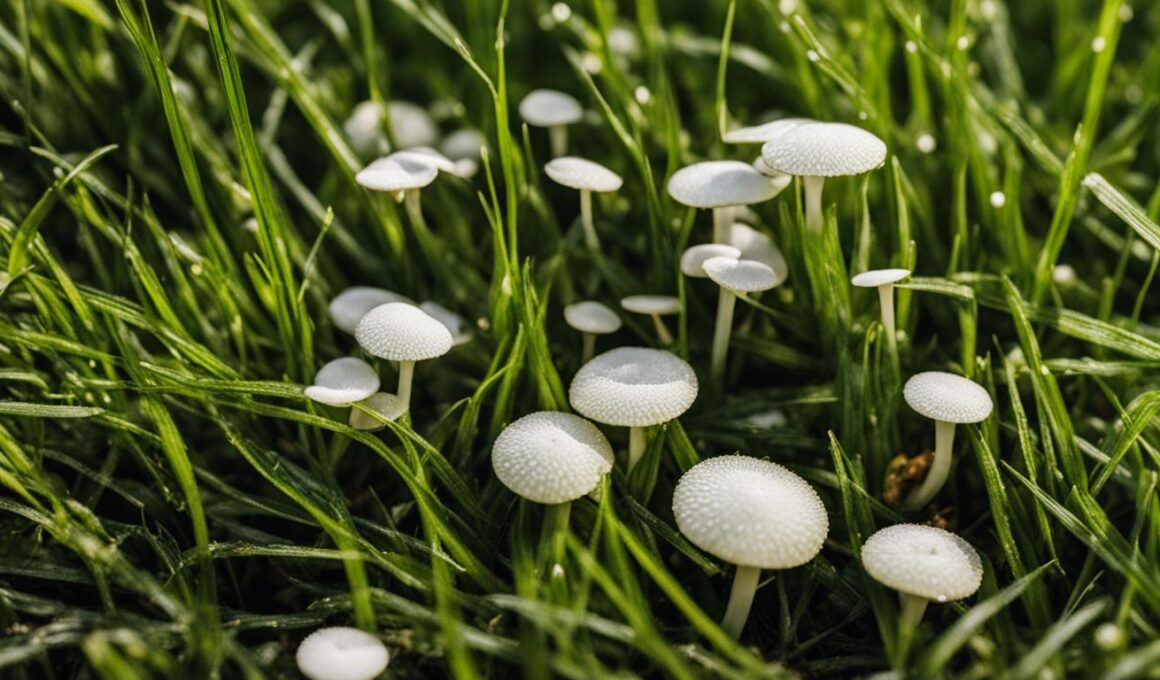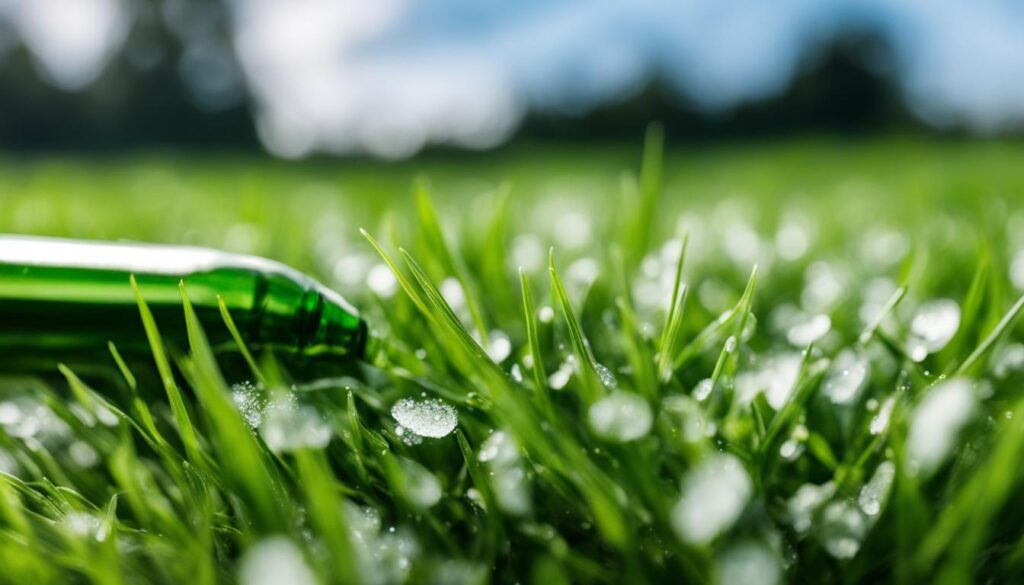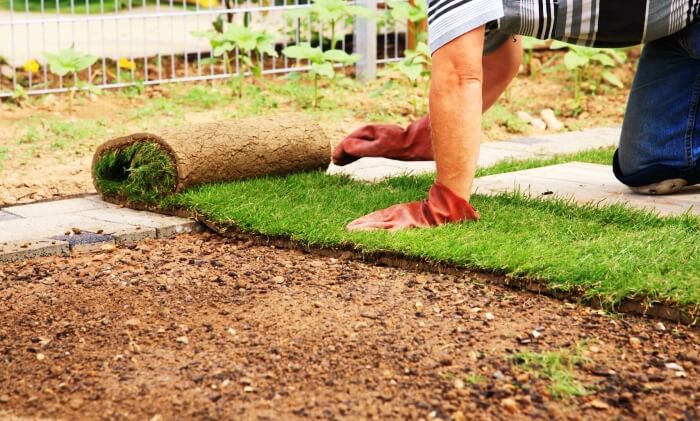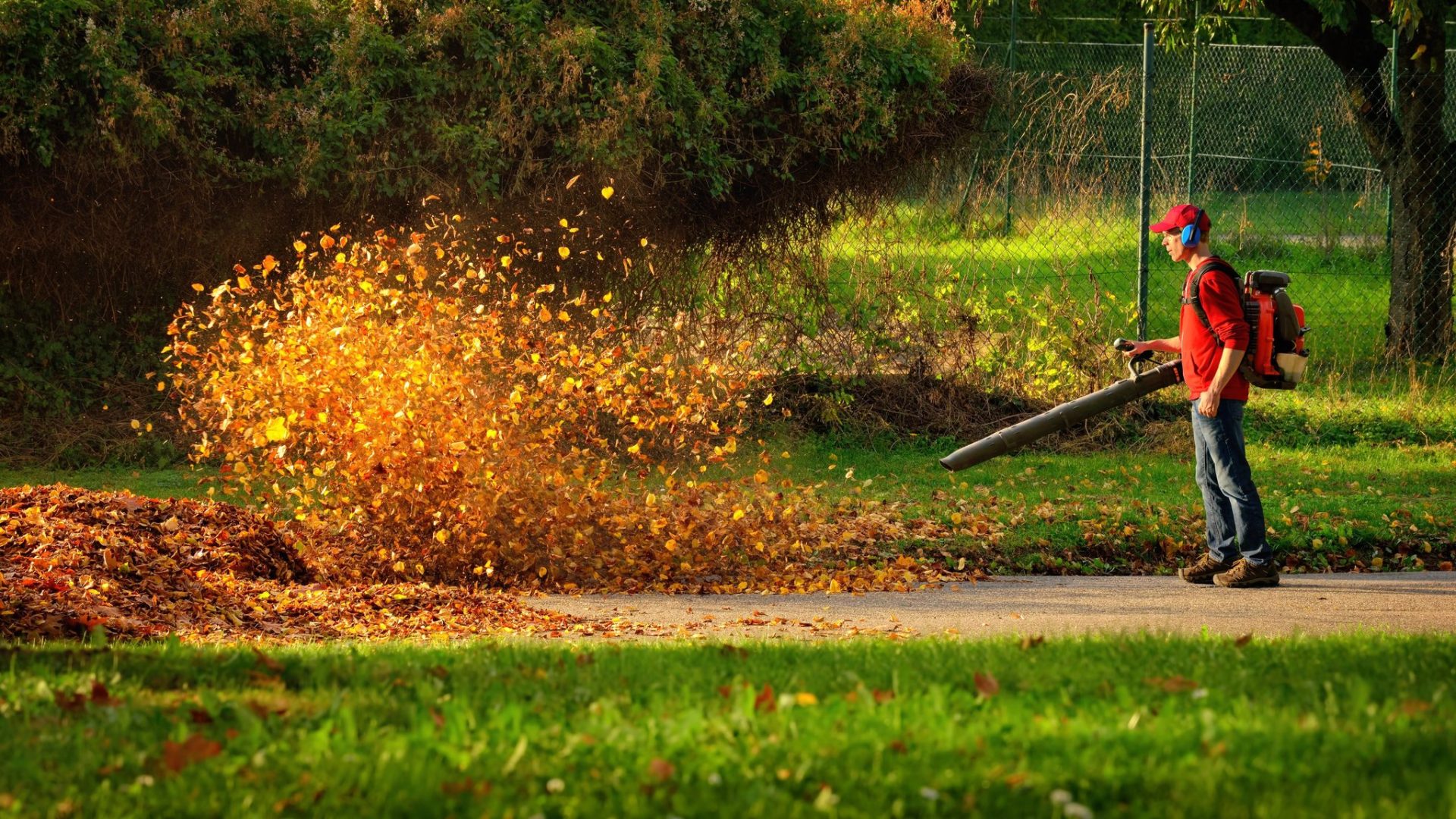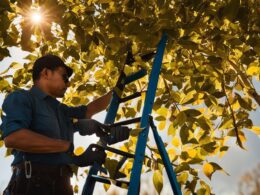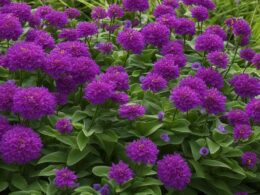If you have noticed a white fungus on your grass, don’t worry – you’re not alone. White fungus on grass, also known as powdery mildew, is a common lawn and garden fungus that can be easily managed with the right lawn care techniques. In this article, we will discuss the symptoms of powdery mildew, the causes and contributing factors, as well as cultural and chemical treatment options to combat this disease and keep your lawn healthy and lush.
Key Takeaways:
- Powdery mildew, or white fungus, is a common lawn and garden fungus that affects cool season grasses.
- Symptoms include white spots or a powdery substance on the blades of turfgrass.
- Reduced air circulation, shade, high humidity, and temperatures between 60-70°F contribute to powdery mildew.
- Cultural treatment options include maintaining a healthy lawn with proper mowing, watering, fertilization, and pruning.
- Chemical treatment options, such as fungicides, can be effective in controlling powdery mildew.
Symptoms of Powdery Mildew on Grass
The symptoms of powdery mildew on grass are easily recognizable. It typically presents as white, grayish spots or a powdery substance on the blades of turfgrass. As the disease progresses, these spots and powdery masses can expand and cover large areas of the lawn. Severe infections can cause the grass to turn yellow or die. It is important to monitor your lawn for these symptoms to take prompt action against powdery mildew.
Causes and Contributing Factors of Powdery Mildew on Grass
Several factors contribute to the development of powdery mildew on grass. Reduced air circulation, caused by dense vegetation or lack of pruning, can create an environment conducive to fungal growth. Grasses in shaded areas are more likely to develop powdery mildew due to the lack of sunlight. Higher humidity levels and damp conditions also make turfgrass more susceptible to this disease. Additionally, powdery mildew thrives in temperatures ranging between 60 and 70 degrees Fahrenheit.
To combat this fungal infection, it is essential to address the underlying causes. Improving air circulation can be achieved by regularly pruning and thinning out dense vegetation. This allows for better airflow and reduces the chances of powdery mildew development. If your lawn has shaded areas, consider thinning out tree canopies or trimming shrubs to increase sunlight exposure. Remove any unnecessary debris or objects that can impede air movement.
Another critical factor to address is high humidity levels. While it may not be possible to control outdoor humidity, proper watering techniques can help minimize excess moisture on the grass blades. Water your lawn early in the morning to allow sufficient time for the foliage to dry throughout the day. Avoid overwatering, as damp conditions can create an ideal habitat for powdery mildew. Maintain a consistent watering schedule, taking into account your grass type and environmental conditions.
Lastly, it is important to note that certain grass varieties are more prone to powdery mildew than others. If you live in an area with known powdery mildew concerns, consider planting shade-tolerant grasses that are less susceptible to the disease. Consult with a local lawn care professional or extension service to determine the best grass species for your region.
Cultural Treatment Options for Powdery Mildew on Grass
Cultural practices are fundamental in preventing and treating powdery mildew on grass. By maintaining a strong and healthy lawn, you can effectively combat this disease. Here are some essential cultural treatment options to consider:
Mowing at the Correct Height
Proper mowing height is crucial for a healthy lawn and can help deter the growth of powdery mildew. Set your mower at the recommended height for your grass type to ensure optimal growth and discourage fungal infections.
Watering Appropriately
Proper watering techniques are essential in maintaining a healthy lawn and preventing powdery mildew. Water deeply but infrequently, allowing the roots to absorb moisture and encouraging deep root growth. Avoid overwatering, as damp conditions promote fungal growth.
Fertilizing as Needed
Applying fertilizer at the appropriate times and rates is essential for maintaining a healthy lawn. Nutrient-rich grass is more resistant to diseases like powdery mildew. Follow recommended fertilization schedules based on your grass type and local climate.
Planting Grass in Sunny Areas
Choosing appropriate grass species for your lawn and planting them in sunny areas can help prevent powdery mildew. Grasses thrive with sunlight and produce a healthier, more resilient lawn that can better withstand fungal infections.
Aeration for Improved Air Circulation
Aerating your lawn improves air circulation and reduces the likelihood of powdery mildew. Aeration helps water penetrate the soil effectively and allows nutrients to reach the grass roots, promoting a healthy environment for your lawn.
Pruning Trees and Shrubs
Pruning trees and shrubs around your lawn can increase sunlight penetration and airflow, preventing the development of a damp and shady environment that favors powdery mildew. Proper pruning practices create an open and well-ventilated space for your lawn.
Using a Suitable Fertilizer Program
Implementing a suitable fertilizer program tailored to your lawn’s needs can enhance its overall health and resistance to diseases like powdery mildew. Choose fertilizers with balanced nutrient ratios to ensure your grass receives the necessary nourishment.
Proper Watering Techniques
Avoiding overwatering and watering at the right times can significantly reduce the risk of powdery mildew. Water your lawn in the early morning to allow sufficient time for the grass to dry before evening, reducing prolonged moisture exposure.
Application of a Lawn Fungicide
In severe cases, when cultural treatment options alone are insufficient, the application of a suitable lawn fungicide may be necessary. Consult with a lawn care professional or follow the manufacturer’s instructions to ensure safe and effective use of a fungicide to combat powdery mildew.
Chemical Treatment Options for Powdery Mildew on Grass
If cultural treatment options alone do not effectively control powdery mildew on your grass, chemical treatments can be a valuable solution. Fungicides are the primary chemical treatment options for eliminating powdery mildew. Two highly effective fungicides for powdery mildew control on grass are Armada 50 WDG and Spectracide Immunox.
Armada 50 WDG contains Triadimefon, a potent active ingredient that targets and eliminates the powdery mildew fungus. It offers excellent control and is easy to use, making it a popular choice among homeowners and lawn care professionals.
Spectracide Immunox, on the other hand, contains Propiconazole, which effectively kills powdery mildew and prevents further infection. It provides long-lasting protection and is suitable for a wide range of grass types.
When using chemical treatments, it is crucial to carefully read and follow the instructions on the product label. Adhering to the recommended dosage and application guidelines ensures both the safety and efficacy of the treatment.
If powdery mildew persists despite using a particular fungicide, it may be necessary to rotate between different fungicides with alternate active ingredients. This helps prevent the fungi from developing resistance and maintains the effectiveness of the treatment.
Remember, always prioritize safety when handling and applying chemical treatments by wearing appropriate protective gear, such as gloves and goggles. Additionally, keep children and pets away from treated areas until the product has dried completely.
Preventive Measures for Powdery Mildew on Grass
Taking preventive measures is crucial in avoiding the recurrence of powdery mildew on grass. To maintain a healthy lawn and minimize the risk of fungal infections, follow these preventive steps:
- Select shade-tolerant grasses: When choosing grass varieties for your lawn, opt for shade-tolerant species that are less susceptible to powdery mildew. Kentucky bluegrass, fine fescue, and tall fescue are good options.
- Overseed with mildew-resistant varieties: Overseeding your lawn with mildew-resistant grass cultivars can further reduce the likelihood of powdery mildew outbreaks. Look for varieties that are specifically bred to be resistant to this fungal disease.
- Prune trees and shrubs: Trim and prune trees and shrubs to decrease shade in your lawn. By reducing shade, you improve air circulation, which makes it harder for powdery mildew to thrive.
- Implement proper watering techniques: Water your lawn in the morning to allow enough time for the grass blades to dry before nightfall. Avoid overwatering, as damp conditions create a favorable environment for fungal growth.
- Apply fungicides preventively: Utilize a disease control product, such as a fungicide, as a preventive measure to keep powdery mildew at bay. Follow the instructions on the product label for proper application.
By following these preventive measures, you can maintain a healthy lawn and reduce the chances of powdery mildew affecting your grass. Keep in mind that these measures are best implemented as part of an overall lawn care routine.
Other Turfgrass Diseases and Identification Tips
While powdery mildew is a common turfgrass disease, it’s important to be aware of other diseases that can impact the health of your lawn. Identifying these diseases correctly is crucial in implementing the appropriate treatment measures. Some of the other turfgrass diseases you may encounter include:
- Anthracnose: This disease is characterized by irregularly shaped brown patches with red or orange borders. It commonly affects cool-season grasses and thrives under hot and humid conditions.
- Brown Patch: Brown patch appears as circular or irregularly shaped patches of brown or yellow grass. It frequently occurs in humid weather and can be identified by the presence of a dark brown ring around the outer edge of the patch.
- Dollar Spot: Dollar spot appears as small, silver dollar-sized bleached patches on the grass. It is caused by a fungus and is most prevalent in warm and humid conditions.
- Leaf Spot: Leaf spot presents as small, dark spots on the grass blades. As the disease progresses, these spots may enlarge and merge, leading to thinning and browning of the affected grass.
- Rust: Rust is characterized by the presence of orange or reddish-brown pustules on the grass blades. It typically occurs in late summer or early fall and is more common in lawns with poor nutrition or inadequate sunlight.
Proper identification of these diseases allows you to choose the most effective treatment methods. If you are unsure about the presence of any turfgrass disease in your lawn, it is highly recommended to seek assistance from a local diagnostic or turfgrass pathology lab. These professionals can provide an accurate diagnosis and offer tailored treatment recommendations for your specific situation.
Conclusion
Combatting white fungus on grass, also known as powdery mildew, requires a combination of cultural and chemical treatment approaches. By following these lawn care tips and implementing the right powdery mildew treatment, you can successfully combat this fungal disease and maintain a beautiful, fungus-free lawn.
To combat white fungus on grass, it is essential to maintain a healthy lawn through proper care. Adequate pruning of trees and shrubs will promote air circulation, thus reducing the chances of powdery mildew development. Consistent watering techniques, such as watering in the morning and avoiding overwatering, will also help prevent the growth of this fungus. Additionally, fertilization is crucial for providing the necessary nutrients to keep your grass strong and resilient against diseases.
When cultural treatments alone aren’t sufficient, chemical treatment options can be considered. Fungicides containing active ingredients like Triadimefon (Armada 50 WDG) or Propiconazole (Spectracide Immunox) have proven to be effective in controlling powdery mildew. However, it is important to carefully follow the instructions provided by the product label for safe and effective application.
By incorporating these lawn care tips and utilizing the appropriate powdery mildew treatment, you can effectively combat white fungus on grass and maintain a thriving, disease-free lawn. Remember to monitor your lawn regularly, take prompt action at the first sign of powdery mildew, and consult with a professional if needed to ensure the long-term health and beauty of your lawn.
How Can I Combat White Fungus on My Grass Using Lawn Care Tips?
To cure white spots on grass, start by reducing shade and improving airflow. Properly water and fertilize your lawn, and keep it well-maintained. Consider using fungicides or natural remedies like neem oil or baking soda. Remove infected grass and overseed bare patches to prevent the spread of the fungus.
FAQ
What is powdery mildew on grass?
Powdery mildew is a common lawn and garden fungus that appears as a white substance on turfgrass blades, resembling a layer of frost on the lawn. It primarily affects cool season grasses like Kentucky bluegrass, fescues, and perennial ryegrasses.
What are the symptoms of powdery mildew on grass?
The symptoms of powdery mildew on grass include the presence of white or grayish spots and a powdery substance on the blades of turfgrass. These spots and powdery masses can expand and cover large areas of the lawn, and severe infections can cause the grass to turn yellow or die.
What causes powdery mildew on grass?
Several factors contribute to the development of powdery mildew on grass, including reduced air circulation, shaded areas with a lack of sunlight, high humidity levels, and temperatures ranging between 60 and 70 degrees Fahrenheit.
How can powdery mildew on grass be treated culturally?
Cultural treatment options for powdery mildew on grass include maintaining a strong and healthy lawn through proper care practices such as mowing at the correct height, watering appropriately, fertilizing as needed, and planting grass in sunny areas. Aeration, pruning trees and shrubs for increased sunlight and improved air movement, and avoiding overwatering are also recommended.
Are there any chemical treatment options for powdery mildew on grass?
Yes, there are chemical treatment options for powdery mildew on grass. Fungicides containing Triadimefon (Armada 50 WDG) or Propiconazole (Spectracide Immunox) are considered to be effective in combating this disease. It is important to carefully follow the instructions on the product label for safe and effective application.
What preventive measures can be taken to avoid powdery mildew on grass?
To prevent powdery mildew on grass, it is recommended to maintain a strong and healthy lawn through proper care and maintenance, such as selecting shade-tolerant grasses, overseeding with mildew-resistant varieties, pruning trees and shrubs to decrease shade and improve air circulation, and implementing proper watering techniques. Applying a disease control product preventively can also help keep powdery mildew at bay.
What are some other turfgrass diseases that can affect the lawn?
Along with powdery mildew, other turfgrass diseases include anthracnose, brown patch, dollar spot, leaf spot, and rust. It is important to be able to identify these diseases correctly to implement appropriate treatment measures.
Where can I seek assistance for accurate diagnosis and treatment recommendations?
If you are unsure about the presence of any turfgrass disease, it is recommended to seek assistance from a local diagnostic or turfgrass pathology lab for accurate diagnosis and treatment recommendations.





